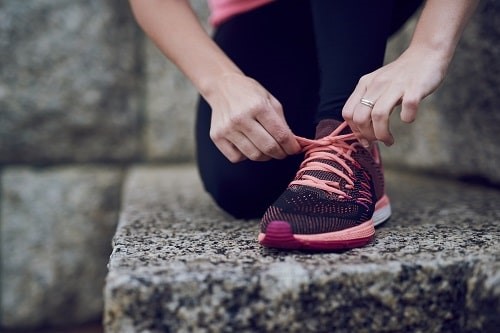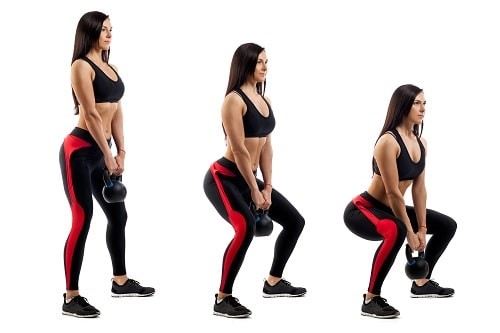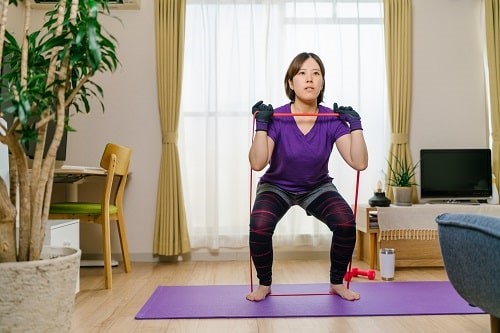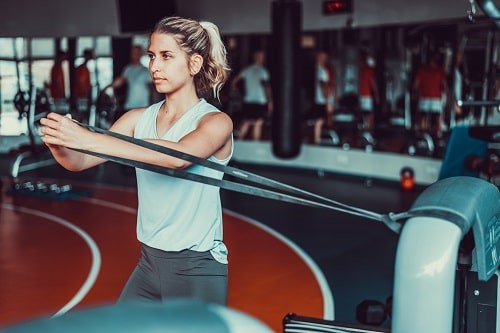Home and office workers can be tempted to become less physically active, with major implications for their health, but simple steps like regular strength exercises can combat problems like muscle loss and a reduction in cardiovascular capacity.
Features
It’s time to move
I first became interested in active office work after reading a paper in the New England Journal of Medicine about physical activity and mortality. I was not surprised to learn that active people had lower mortality than inactive people over the following eight years of the study; what did surprise me was that even short periods of mild activity – 15 minutes a day – were protective.
What was it then about inactivity that was harmful? I turned to the bedrest studies conducted by NASA to investigate the effects (on Earth) of inactivity on otherwise healthy astronauts. It seems that inactivity causes metabolic changes – known as ‘metabolic inflexibility’ – which include lowered capacity to use fat as an energy source – and functional changes in the form of diminished muscle mass and strength.
 We should all undertake 150 minutes of moderate activity per week and two sessions of strength training. Photograph: iStock
We should all undertake 150 minutes of moderate activity per week and two sessions of strength training. Photograph: iStock
In terms of physical activity, sitting in an office chair all day isn’t much different from staying in bed all day and the effects on health appear to be similar. Prospective studies of ‘sedentarism’ demonstrate that daily sitting hours are associated with the development of adverse health outcomes. Anything more than eight hours per day seems harmful; whereas many of us will sit for more than that if we include sitting to eat meals, sitting while commuting or watching TV.
Regular exercise has a protective effect but it is an independent factor (in other words, even people who exercise a lot will benefit if they sit less).
So, is sitting the new smoking? Yes, in the sense that they are both bad habits but the analogy breaks down when we remember that the health outcomes are different and while there is often an occupational requirement to sit, the same does not apply to smoking.
It is well known that muscle loss (known as ‘sarcopaenia’) is part of normal ageing. Recent research also indicates that the loss is greater in inactive people and it is associated with increased mortality. Estimates vary, but inactive people lose about one per cent of their muscle mass every year after their mid to late 20s, having lost around 25 per cent of their muscle mass by the time they reach 60 years of age.
Since they are more likely to have gained weight overall, rather than lost it, they will be carrying around a heavier body with fewer muscles to move it – hence the perception of ‘slowing down’ with age, while finding activities of daily living more challenging.
 Dr Bridger: Given what we know about uninterrupted sitting, perhaps we need to rethink our conception of what a ‘normal’ workday should look like.
Dr Bridger: Given what we know about uninterrupted sitting, perhaps we need to rethink our conception of what a ‘normal’ workday should look like.
Taken together, these findings underpin official guidance from the Office for Health Improvement and Disparities (formerly Public Health England) that we should all undertake 150 minutes of moderate activity per week and two sessions of strength training.
Healthy hybrid working: moderate activity
One of the advantages of working from home is that less time is spent commuting (which for most of us involves sitting in the car, bus or train). However, time saved sitting during the commute is only useful if it is replaced with activity (rather than sitting at home). Home workers could easily achieve 150 minutes of moderate activity per week, by going for a brisk walk in the hours they would normally spend commuting (the average daily commute in the UK is about one hour).
Failing this, there are a number of active workstation options that can increase activity levels either at work or in the home office:
- Treadmill desks: these may have health benefits because the physical activity level (even when strolling at around 1.5km/hr) is double that when seated
- Pedal desks: similar benefits to treadmill desks when pedalling at just under 60rpm
- Standing desks: good for changing posture from sitting and for conducting tasks where objects are manipulated.
 Online meetings where everyone stands, or in person meetings where people walk, are simple ways to build in active working. Photograph: iStock
Online meetings where everyone stands, or in person meetings where people walk, are simple ways to build in active working. Photograph: iStock
Standing is a good posture for many tasks compared with sitting – for speaking on the phone, meetings and any tasks that require manipulating objects. If you are doing intense work at the computer, sit on an office chair or high stool (and use the stairs, not the lift in the office).
Since prolonged sitting is more harmful than sitting per se (when sitting for the same amount of time each day) active workstation options are worth considering because they can help to break up long periods of inactive sitting with healthier activities.
However, it is worth noting that systematic literature reviews of active office interventions (like height adjustable sit-stand desks) show that there is weak evidence for their benefits, partly because these interventions are relatively new and it takes time to conduct high-quality research studies.
Office workers given standing desks normally don’t stand for long. This was demonstrated by myself and other ergonomics researchers in the 1990s. We observed that people stand very still when standing to do mentally demanding computer work. Standing still is unnatural, unhealthy and soon leads to discomfort. People soon sit down.
Healthy hybrid working: strength training
The good news is that muscle loss can be stopped and significantly reversed at any age with regular strength training. The main drawback is that many of us do not know how to participate in strength training and lack the necessary equipment (for many years ‘exercise’ was associated with running in the eyes of many and strength training was less popular).
Since sarcopaenia (like the loss of cardiovascular capacity in those who don’t exercise) is progressive over the lifespan, a long-term commitment is required. Probably the best way to start is to be assessed by a qualified fitness instructor who specialises in strength training and begin a programme of regular exercise. Alternatives are to join one of the many classes (such as ‘bodypump’ or calisthenics) where gaining strength rather than flexibility or cardiac capacity is the main aim.
For home workers, simple exercises can be improvised using resistance bands (which are inexpensive) or improvised weights using, for example, empty plastic bottles filled with water. Indeed, with some imagination, the home can become your gym. For a quick ‘glute’ (gluteal muscle) workout try crawling up the stairs on your hands and knees without using your feet (you’ll be surprised how difficult it is).
The benefits of strength training are increased muscle mass and strength, increased metabolic capacity and increased ability to metabolise fatty acids.
See the photos further below for some basic exercises that can be performed with dumb-bells, kettlebells, resistance bands or improvised weights.
Happy hybrid working
Working hours are defined as the time that the employee is at the employer’s disposal. This explains why some countries have introduced rules or guidance on the ‘right to disconnect’ – essentially the right to not be available outside agreed working hours or during breaks.
For many years, human factors specialists have focused on designing workspaces to minimise the risk of musculoskeletal disorders. The irony is that the very workspaces that enable employees to sit at their screens in comfort all day also encourage prolonged sitting (a health hazard with more subtle and long-term consequences).
Disconnecting throughout the day is to be encouraged if ‘down-screen’ time is used for increased physical activity. Employers can help maintain the health and wellbeing of the hybrid workforce by supplementing the usual guidance on display screen equipment, posture and seating and so on, with advice on how to meet the Office for Health Improvement and Disparities’ recommended activity levels at work and at home.
For many years, in Japan, the working day was interrupted by exercise breaks. Whether and how such a policy could be transferred to hybrid working in the UK is beyond the scope of this article. Suffice to say, the internet provides new avenues for delivering support for physical activity enhancement at the office and when working at home. Possible examples include running live exercise classes, sharing exercise videos and tips, sending exercise alerts and reminders and encouraging online meetings where everyone stands.
Given that long periods of uninterrupted sitting are more harmful than shorter periods with breaks (even if the total daily sitting hours are the same); and given that vigorous exercise (even for very short periods) is more protective than moderate exercise (such as walking), perhaps we need to rethink our conception of what a ‘normal’ workday should look like? Everyone will benefit if they stop work to exercise and the employer may well gain a healthier workforce.
Five basic exercises that can be performed with dumb-bells, kettlebells, resistance bands or improvised weights
Deadlift using a kettle bell. A basic strengthening exercise for almost the whole body

Squat using resistance bands. Excellent exercise for the legs and the ‘posterior chain’ (muscles at the rear of the trunk and thighs)

Seated shoulder press with dumb-bells (you can use a tin of baked beans or plastic bottle filled with water instead of dumb-bells)
Rowing with resistance bands
Chest press with resistance bands

Dr Bridger is a past president of the Chartered Institute of Ergonomics and Human Factors, and a consultant and writer in human factors. He is also a qualified fitness instructor and personal trainer. For more information and to contact him see:
FEATURES

Underpinning safety training with neuroscience for long lasting impact
By SSE Active Training Team (ATT) on 30 November 2025
A behavioural safety training programme developed by Active Training Team for energy provider SSE has been carefully designed with neuroscientific principles in mind – resulting in a prestigious industry award for Best Training Initiative in 2024.

Why a painted line will never be enough
By UK Material Handling Association (UKMHA) on 20 November 2025
Businesses that operate material handling equipment like forklifts are being urged to submit accident and near miss details to a new confidential reporting portal so the industry can identify what needs to be done to improve safety standards.

Why workplace transport training is changing in 2026 and what it means for employers
By AITT on 26 November 2025
New workplace transport training categories due in January mean it is essential to ensure operators of material handling equipment have the necessary training for the exact type of machine they use, and accredited training providers are an ideal source of advice and conversion training.



